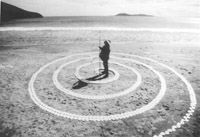Mexico, 1998, 96 min., color
Spanish w/ English subtitles
 Damian, an environmental installation artist, may or may not have accidentally run over a pregnant woman. Haunted by guilt, and decides to return to his ancestral roots, and track down his grandmother's grave in San Francisco de la Sierra, to make amends for his sins. He sets off on a journey south of the Californian-Mexican border, leaving his heavily pregnant wife behind. He drives his Chevrolet ute across the desolate Mexican desert, where mangled cars are strewn like corpses, and little by little the landscape refuse to hide its violent nature behind modernity. He encounters his people who talk about the gringos and the cave paintings in Baja, adds Baja to his destination, and builds sculptures using Polaroid photographs, rocks, shells, whale bones and his vehicle to go back to the modern times, the Chevy. In the desert, time ceases to exist, there is only night and day. He sleeps under the stars and learns to live close to the land in the indigenous Mexican way while pushing his own physical boundary to pay his debt by insisting on walking instead of travelling on a mule, confronting thirst, hunger and exhaustion, and anticipating disorientation. A meeting with his distant cousin, Arce, opens his way to his ancestral roots, helps him find his way to his grandmother's grave, and together they explore the paintings in the mountain caves and trace the roots to their family tree.
Damian, an environmental installation artist, may or may not have accidentally run over a pregnant woman. Haunted by guilt, and decides to return to his ancestral roots, and track down his grandmother's grave in San Francisco de la Sierra, to make amends for his sins. He sets off on a journey south of the Californian-Mexican border, leaving his heavily pregnant wife behind. He drives his Chevrolet ute across the desolate Mexican desert, where mangled cars are strewn like corpses, and little by little the landscape refuse to hide its violent nature behind modernity. He encounters his people who talk about the gringos and the cave paintings in Baja, adds Baja to his destination, and builds sculptures using Polaroid photographs, rocks, shells, whale bones and his vehicle to go back to the modern times, the Chevy. In the desert, time ceases to exist, there is only night and day. He sleeps under the stars and learns to live close to the land in the indigenous Mexican way while pushing his own physical boundary to pay his debt by insisting on walking instead of travelling on a mule, confronting thirst, hunger and exhaustion, and anticipating disorientation. A meeting with his distant cousin, Arce, opens his way to his ancestral roots, helps him find his way to his grandmother's grave, and together they explore the paintings in the mountain caves and trace the roots to their family tree.
This film is a visual journey in itself - the jump cuts to Los Angeles, the accident, his wife, the new life inside her, the cave paintings, and familiar shapes against the unfamiliar. The desert itself may be a surreal place like Dali's or a useless landscape - beautiful, but inhabitable, menacing and immensely void. Yet, it is this humble space of minimal existence that should be natural to Damian and his people. This film takes us retreat from the world to tour with Damian to his other world, which is also the part of our world, yet unseen and never thought of, and Damian does all the suffering in the heat for us, but of course, after the retreat he steps further, since the pilgrimage is also his spiritual journey. Lucky if by the end of the film you are as enlightened as he is; save your tax-return money.
Some might say this film recalls Antonioni or Bunuel's works. To me, it also resonates with Peter Greenaway's A Walk Through H, where we trace Damian's path along the map with the Glassian minimalist soundtrack (unfortunately, it seemed like Damian or Bolado threw away the map and the record halfway through the film since the map and the music stopped somewhere). Just like Damian's sculptures, this film doesn't demand to be understood, but it wants you to follow Damian's metaphysical journey.
natalia laban
comments? email the author
return to the 1999 Sydney Film Festival index